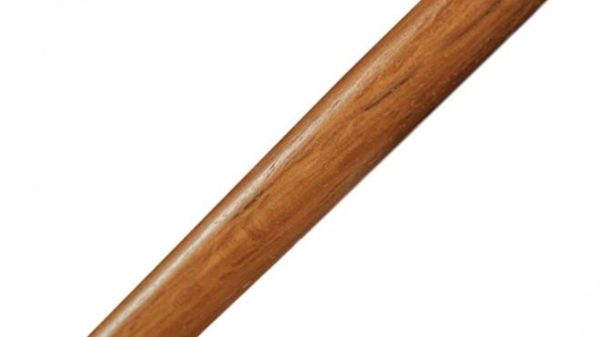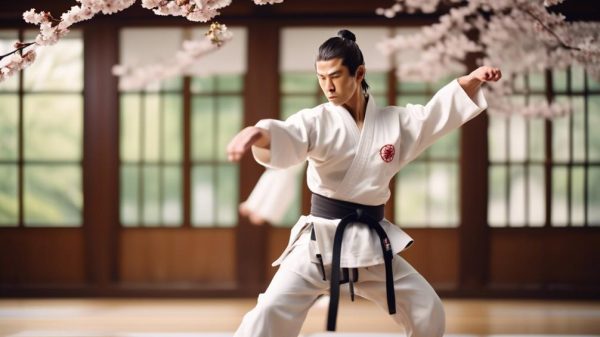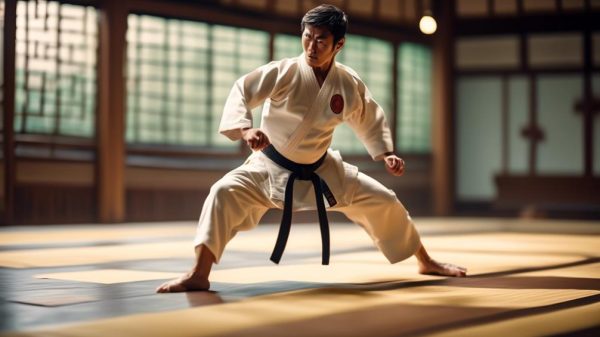Lathi refers to an Indian stick-fighting martial art using a five to six foot wooden staff. Skilled lathi wielding flows like water.
Practitioners build dexterity, quickness and rhythmic movements training with the long stick through solo drills and sparring exchanges. Grips change along the staff.
Flourishing the lathi adapts techniques from ancient battlefield swordsmanship translating to the wooden pole. Spinning motions interplay with forceful jabs and deflections.
Sensitivity training brings lathi fluidity stunting attacks with subtle deflections then countering crisply. Circularity guides rather than meets energy head on for control.
Mastering elusive yet decisive lathi movements reflects Eastern concepts of yielding to add precision in guiding an opponent’s motions rather than imposing force.
Lathi: An Overview
Discover the essence of self-defense through Lathi, a formidable Indian martial art wielding a sturdy bamboo staff as its cornerstone.
This ancient practice, deeply rooted in Bangladeshi and Indian stick-fighting martial traditions, isn’t merely about combat; it’s an art form, a discipline that sharpens both body and mind.
In Lathi, the weapon used—a six to eight-foot wooden staff—is an extension of oneself, demanding respect and control.
The martial arts version known as Lathi Khela encapsulates a spectrum of striking, blocking, and agile footwork techniques, each maneuver a testament to the art’s sophistication.
While you train, remember this staff has a dual purpose; it’s also used mainly for crowd control by Indian police and military units, showcasing its practical application beyond the dojo.
Embarking on this path, you’re not just learning to wield a staff; you’re embracing a heritage.
However, training should be used safely, integrating rigorous conditioning exercises and sparring drills to build your prowess.
Mastery in Lathi isn’t just about physical strength—it’s the culmination of precision, discipline, and an indomitable spirit.
Historical Significance
Unveil the fascinating history woven into the ancient roots of the Lathi, a weapon that has significantly influenced cultures and endured the test of time.
Its cultural impact is profound, reflecting the traditions and valor of warriors who once wielded it in battle.
Witness the remarkable evolution of the Lathi, from its origins in primal self-defense to becoming a symbol of martial heritage.
Ancient Weaponry Roots
Uncover the ancient origins of weaponry, where traditional arms not only influenced warfare but also gave rise to martial arts practices that resonate across history.
The Lathi, a weapon rooted in Indian martial arts, epitomizes this rich legacy with its straightforward yet efficient design.
Emerging from the traditions of Bangladeshi and Indian stick-fighting martial arts, the Lathi served not only as a weapon but also as an extension of the warrior’s skill, refined through dedicated training and specialized techniques.
As you pursue expertise in this discipline, recognize the deep historical significance of the Lathi, which played a pivotal role in both crowd management and individual combat.
Its profound impact on martial arts transcends time, connecting ancient battle strategies with modern combat disciplines.
Cultural Impact
The Lathi holds a deep cultural significance that extends beyond its historical use as a weapon. It has become a symbol of resilience and defiance in the face of oppression, leaving a profound impact on Asian martial arts and folklore.
Originating from Indian tales and mythology, the traditional Lathi has played a pivotal role in shaping the cultural landscape of Southeast Asia, particularly in the Bangladeshi and Indian stick-fighting martial arts.
In Bangladesh, the practice of Lathi Khela is deeply rooted in historical significance, connecting practitioners to a legacy of combat and artistry.
Influenced by traditional Chinese staff techniques, the Lathi continues to resonate in the hands of those who strive for mastery and honor its storied past.
The cultural impact of the Lathi is evident in its enduring legacy, embodying a rich tradition that transcends physical boundaries and speaks to the resilience of those who wield it.
Evolution Through Ages
The practice of martial arts has evolved across centuries, reflecting changes in human conflict, culture, and awareness.
As a skilled martial arts instructor, you understand that the Lathi holds significance beyond Bangladeshi and Indian stick-fighting techniques; it embodies the enduring evolution through ages.
- Historical Significance: Initially utilized as weapons of war, Lathi techniques were refined to train ancient warriors.
- Cultural Preservation: Asian martial arts serve as custodians of ancient wisdom and traditional combat tools.
- Diverse Influence: Various martial arts styles intersect, enriching the landscape of martial arts training.
- Modern Adaptation: Today’s Lathi encompasses a blend of traditional and contemporary martial arts techniques.
Embrace this rich legacy. With each strike and defense, you not only practice but also perpetuate a living history.
Fundamental Techniques
The mastery of fundamental techniques forms the bedrock of your martial arts journey, encompassing crucial stances, strikes, blocks, and kicks that will shape your combat skills.
In the realm of Bangladeshi and Indian stick-fighting martial arts, such as Lathi, these foundational skills are of utmost importance.
As you engage in martial arts classes, you’ll realize that every precise movement, from the fluidity of your strikes to the stability of your stance, is vital for efficiency and safety.
Your dedication to these techniques sets the stage for all subsequent weapons training.
Practice is key to ingraining the proper technique as second nature. Training equipment like practice mats provide a secure environment for honing your skills without the risk of injury.
The use of these mats in your training regimen is essential to reinforce your learning and safeguard your body as you strive for mastery.
Training and Exercises
As you embark on the path of Lathi, integrating structured training and exercises into your regimen is crucial for honing your martial arts prowess.
This Bangladeshi and Indian stick-fighting martial art demands dedication and precision to master its complexities.
Here’s how you can elevate your practice:
- Ensure every session is supervised by a trained martial arts instructor. Their guidance is as vital as the foundation of a temple, ensuring that proper technique is utilized, reducing the risk of injury, and refining your skills to perfection.
- Adopt a regimen that mirrors the discipline of Japanese martial arts, Korean martial arts, and Chinese martial arts. This includes a rigorous warm-up, consistent practice, and the use of protective gear, safeguarding your journey to mastery.
- Create a sacred space for martial arts techniques and training. Personalize your home dojo with motivation that speaks to your warrior spirit, be it through posters, proper equipment, or the serenity of the space itself.
- Incorporate bodyweight exercises into your daily routine. Like the roots of an ancient tree, these exercises will ground your physical capabilities, making you an unyielding force within the Lathi tradition.
Walk the path with passion, precision, and the heart of a true martial artist.
Lathi in Self-Defense
After mastering the fundamental movements of the Lathi, it’s time to apply these skills for self-defense.
Gain a deep understanding of practical defense techniques to effectively neutralize potential threats with precision.
Stay tuned as we delve into essential training and safety tips for wielding this powerful martial arts weapon, ensuring your protection in the face of danger.
Lathi Techniques Overview
Lathi Techniques Overview
Discover the art of wielding a traditional lathi stick for self-defense with remarkable efficacy. As you strive for Black Belt mastery, it’s essential to delve into the intricacies of lathi techniques with the precision of a seasoned warrior.
- Master the Fundamentals: Utilize each technique purposefully, as every motion embodies power and control.
- Integrate Agility and Strength: Your body serves as an extension of the lathi, drawing from the rich heritage of Bangladeshi and Indian stick-fighting martial arts.
- Tactical Implementation: Gain a thorough understanding of these techniques by dissecting each explanation and internalizing its fundamental principles.
- Guided Advancement: Achieve mastery under the watchful guidance of a martial arts instructor, honing every strike and defense to perfection.
Practical Defense Applications
In the realm of self-defense, the lathi proves to be an invaluable asset, equipping individuals with the ability to thwart potential threats through a range of precise strikes and blocks.
As a practitioner of Bangladeshi and Indian stick-fighting martial arts, mastering the lathi for practical defense applications requires unwavering dedication.
Martial arts techniques and training are meticulously honed under the vigilant guidance of an experienced instructor to ensure both safety and effectiveness.
| Martial Arts Technique | Practical Application |
|---|---|
| Precise Striking | Disabling an assailant’s limb |
| Blocking Maneuvers | Deflecting an incoming attack |
| Disarmament Techniques | Removing a weapon from the attacker |
| Controlled Sweeps | Taking down an opponent |
Important Safety Tips for Lathi Training
When practicing defensive maneuvers with the lathi, it’s essential to prioritize safety to avoid injuries and optimize skill development.
Here are key measures to ensure your safety during training:
- Select a Spacious Training Area: Find an open and spacious location to minimize the risk of accidental injuries during practice sessions.
- Master Your Techniques: Dedicate time to perfecting your martial arts techniques under the guidance of a qualified instructor to prevent injuries and enhance your skills.
- Wear Protective Gear: Prioritize safety by using protective equipment to minimize the impact of strikes and reduce the risk of injuries.
- Regular Practice and Review: Continuously reinforce your knowledge and skills by practicing defensive moves regularly, ensuring they can be effectively and safely applied in real-life situations.
Take these safety guidelines seriously as they serve as your shield in your pursuit of mastering martial arts.
Cultural Impact
Martial arts have a profound influence on global culture, reflecting diverse styles that embody the philosophies and traditions of their origins.
As a martial artist, you’re part of a rich lineage that includes the Bangladeshi and Indian stick-fighting martial art of Lathi, reminiscent of the tales of Robin Hood’s quarterstaff.
Lathi, with its short staff, has made a significant cultural impact, weaving its narrative into the tapestry of Asian martial arts.
The techniques and exercises of this art form resonate with the precise movements of Kung Fu while retaining a distinct cultural identity.
Lathi not only enhances your physical prowess but also connects you to a heritage of discipline and resilience.
Enjoying the elegance and practicality of Lathi means mastering a weapon and inheriting a legacy that has shaped lives and stories across generations.
Your journey towards mastery in the martial arts involves more than just learning to strike or defend—it’s about understanding the cultural significance of your practice.
Lathi offers a unique perspective, blending the wisdom of the East with the dynamism of combat, enriching both your skill set and your appreciation for the art’s profound cultural resonance.
Modern Practice and Challenges
As you immerse yourself in the rich history and discipline of Lathi, you’ll also face the changing dynamics of modern martial arts practice.
This Bangladeshi and Indian stick-fighting martial art demands not just proficiency in traditional techniques and training, but also a grasp of the contemporary practice and challenges essential for staying relevant in today’s fast-paced world.
Here are key aspects crucial to your journey as a Lathi practitioner:
- Alignment with Law Enforcement: Tailor techniques to suit self-defense and law enforcement situations while ensuring compliance with legal frameworks.
- Utilization of Modern Equipment: Incorporate striking bags, focus mitts, and kicking shields to enhance the power and precision of striking and kicking techniques.
- Innovation in Training: Adapt to modern combat strategies while preserving the fundamental principles of Lathi.
- Guidance from a Proficient Instructor: Seek an instructor who can navigate the fusion of tradition and modernity, and lead you towards mastery in both realms.
Your dedication to Lathi is a journey that bridges ancient wisdom with the realities of today.
Train with focus, train with intent, and let each strike be a testament to your commitment.
How Many Styles of Martial Arts Are There?
There are numerous styles of martial arts, each originating from different cultures and regions, and encompassing a wide range of techniques for self-defense, competitive fighting, and weaponry training.
These styles have been refined through rigorous physical conditioning and mental discipline, making them truly diverse and impactful in the world of combat sports.
How to Do Martial Art?
To become skilled in martial arts, focus on perfecting combat stances, developing power, and enhancing speed through drills.
It’s important to prioritize flexibility training, mental discipline, and injury prevention.
Devote time to refining techniques and mastering self-defense tactics to achieve true proficiency.








